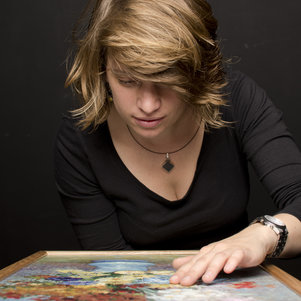Night Watch scanned in 3D for the first time
A specially designed 3D scanner, based on 3 cameras and a projector, moves along the surface of the Night Watch in the Rijksmuseum. In the coming weeks, researcher Willemijn Elkhuizen will map out the depth differences of the characteristic painting. Many facets of the Night Watch have already been investigated, but the surface has never been studied so extensively.
‘You can see it as a benchmark,' says Elkhuizen. ‘By mapping out the differences in the height of the paint we can clearly see the current state of the painting, and the effect the ravages of time have had so far on the painted surface. When we repeat such measurements, for example in 10 or 20 years' time, we can also find out how and at what rate changes in the 3D surface take place.' The 3D scan technique can also be used during the restoration process, by making a 3D scan before, during and after an intervention.
Scanning the Night Watch takes several weeks, with the cameras moving along the canvas from the morning to the evening. The principle of scanning can be compared to how our eyes perceive height differences. The image of our left and right eye is slightly different, which makes it possible to see depth. According to the same principle, the cameras are focussed on the same point from different angles, which enables the difference in height to be determined accurately. After shooting, all captured images have to be processed with the help of the computer, so that a height profile map can be created. Only then can the surface of the Night Watch be studied.
Earlier, Willemijn Elkhuizen, together with other researchers, was involved in the research into the famous Girl with a Pearl Earring by Johannes Vermeer. You can read more about that in this story.
Contact
Dr. ir. Willemijn Elkhuizen, W.S.Elkhuizen@tudelft.nl, +31 15 27 81041
Press officer Dimmy van Ruiten, D.M.vanRuiten@tudelft.nl, +31 15 27 81588

